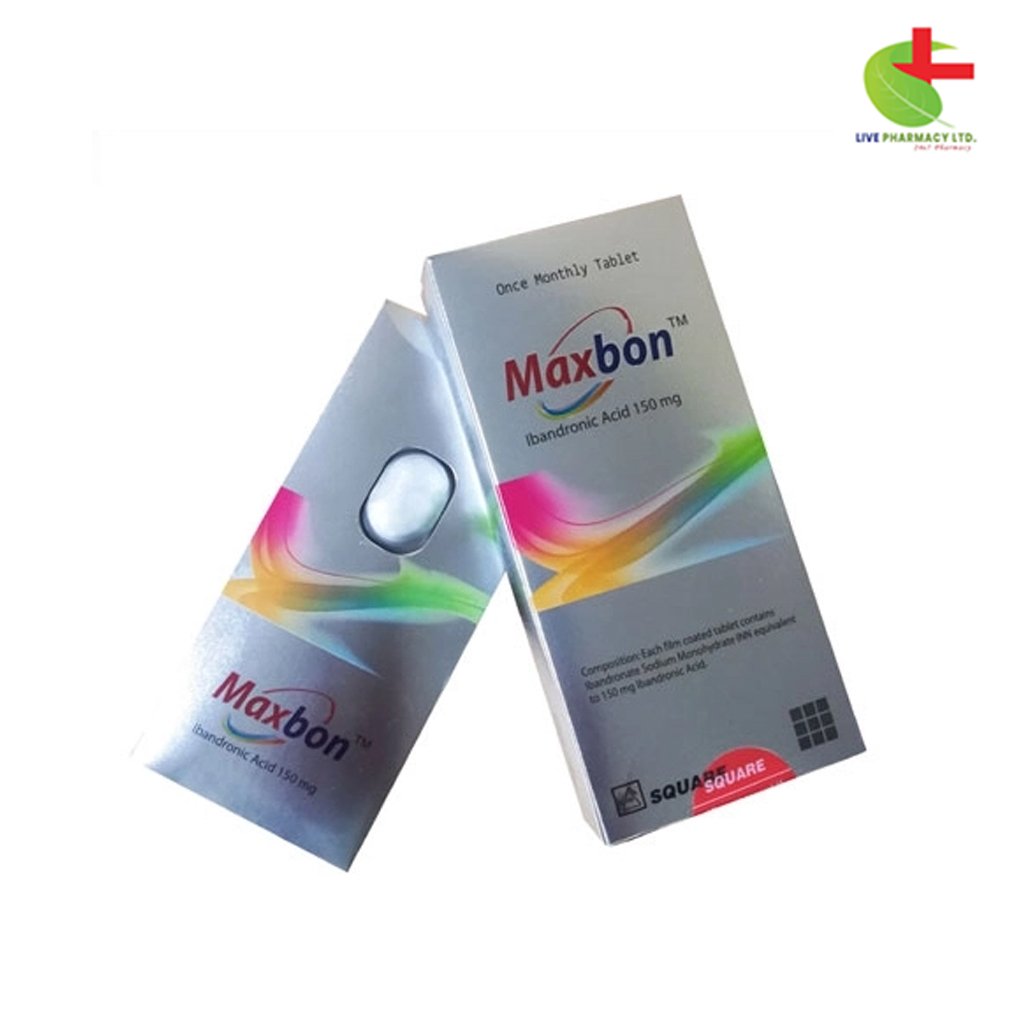Maxbon 150
510.00৳ Box
- Maxbon: Your go-to solution for osteoporosis treatment and prevention.
- Formulated for women, particularly postmenopausal individuals, and men.
- Powered by ibandronic acid, it effectively inhibits bone resorption.
- Flexible dosing regimens and potent action promote bone health.
- Trust Maxbon for comprehensive osteoporosis care and increased bone mineral density.
 Brand
Brand
|
Square Pharmaceuticals PLC |
|---|---|
 Generics
Generics
|
Ibandronic Acid |
Indications
Maxbon serves as an effective solution for:
- Treating osteoporosis in women, particularly those in the postmenopausal stage.
- Preventing osteoporosis in women, especially postmenopausal individuals.
- Preventing and treating osteoporosis in men. Osteoporosis diagnosis may involve identifying low bone mass (T-score <-2.0 SD) alongside osteoporotic fracture history or a low bone mass (T-score <-2.5 SD) without prior osteoporotic fracture documentation.
Pharmacology
Ibandronic acid, the active component in Maxbon, operates by inhibiting bone resorption. Through various studies, it has demonstrated efficacy in preventing bone destruction due to factors like gonadal function cessation, retinoids, or tumors. Its potent inhibition of osteoclastic activity, particularly noted in animal models, underscores its effectiveness. Notably, ibandronic acid’s selective action on bone tissue is attributed to its high affinity for hydroxyapatite, the bone’s mineral matrix. This action reduces bone resorption without directly affecting bone formation, leading to increased bone mass in postmenopausal women.
Dosage & Administration
For treatment, the recommended dosage of Ibandronic acid is one 150 mg film-coated tablet per month, ideally taken on the same day each month. It should be consumed 60 minutes before any oral intake or medications, with plain water, while maintaining an upright position. Patients should avoid lying down for at least 60 minutes after ingestion. If a dose is missed, instructions for resumption should be followed as advised.
Interaction
Potential interactions with calcium supplements, antacids, or certain oral medications containing multivalent cations should be considered. Patients are advised to wait 60 minutes after taking Maxbon before consuming other oral medications to avoid interference. Additionally, pharmacokinetic interaction studies indicate no significant interactions with specific medications, ensuring Maxbon’s safety profile.
Contraindications
Maxbon is contraindicated in patients with known hypersensitivity to ibandronic acid or its components, uncorrected hypocalcemia, or esophageal abnormalities hindering esophageal emptying. Patients unable to maintain an upright position for at least 60 minutes are also advised against its use.
Side Effects
Common side effects of Maxbon may include dyspepsia, nausea, diarrhea, abdominal pain, muscle aches, headaches, and dizziness.
Pregnancy & Lactation
Usage of Maxbon is not recommended during pregnancy or lactation due to potential adverse effects on fetal development and transmission through breast milk, respectively.
Precautions & Warnings
Patients with hypocalcemia or underlying gastrointestinal issues should be closely monitored when using Maxbon. Compliance with dosing instructions is crucial to minimize the risk of esophageal adverse effects. Physicians and patients should remain vigilant for any signs of esophageal reactions and promptly seek medical attention if symptoms arise.
Use in Special Populations
Dosage adjustment is not required for patients with mild or moderate renal impairment, while special considerations should be made for individuals with severe impairment. No dosage adjustments are needed for patients with hepatic impairment or in elderly populations.
Overdose Effects
In the event of overdose, no specific treatment guidance is available for Maxbon. However, management typically involves addressing upper gastrointestinal adverse events. Patients should avoid inducing vomiting and maintain an upright posture.
Therapeutic Class
Maxbon belongs to the class of bisphosphonate preparations, known for their efficacy in treating bone-related disorders.
Storage Conditions
To maintain potency, Maxbon should be stored below 30°C, away from light and moisture, and kept out of reach of children.













Reviews
There are no reviews yet.